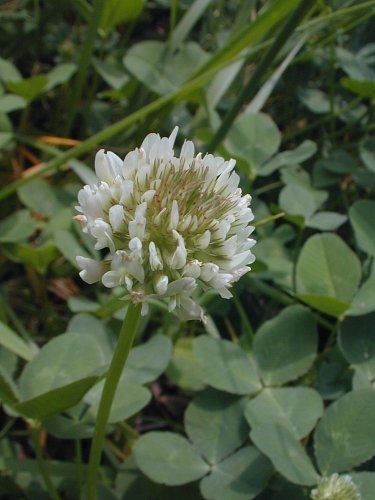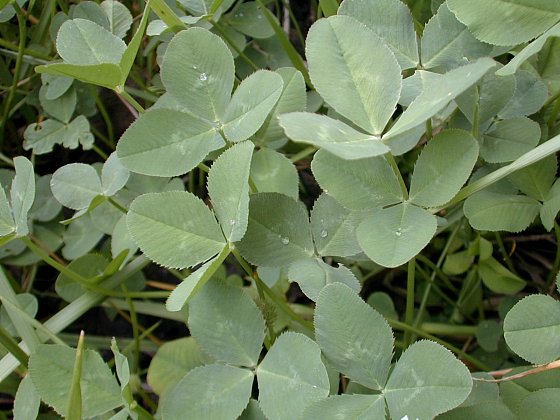Description: This herbaceous perennial plant is about 6" tall, branching from the base. Initially, it produces several compound leaves from a short stem that grows only a little, after which this stem rapidly elongates and becomes up to 1' long. These elongated stems sprawl along the ground and have the capacity to root at the nodes. They are hairless and light green. The alternate compound leaves are trifoliate and hairless. They occur at intervals along the elongated stems and have long hairless petioles. The leaflets are obovate or ovate. Their margins are finely serrate. Across the upper surface of each leaflet are white markings in the form of a chevron (an upside down "V"), although for this species these markings are often degenerate, irregular, or absent. Each leaflet is about ¾" long and about half as wide. At the base of each petiole there are a pair of small lanceolate stipules that are light green and membranous; sometimes they wrap around the elongated stems. Each stipule is less than ½" in length.

Flowerheads about
¾" across are produced on long naked stalks (peduncles) that are
unbranched, hairless, and leafless These flowering stalks are usually a little
taller than the compound leaves. Each flowerhead has 20-50 flowers and
is more or less globular in shape. Each flower is narrowly tubular,
consisting of a green calyx with 5 narrow teeth and 5 petals that are
white or pinkish white. When fully open, there is a small standard and
2 side petals that enclose the keel. The teeth of the calyx are equal
to, or less than, the length of the calyx tube. Each flower has a very
short pedicel. The blooming period occurs intermittently for several
months, from late spring through the fall. The flowers gradually turn
brown and are replaced by seedpods. Each little seedpod contains only a
few seeds, which are flat, round or slightly heart-shaped, and
variously colored. The root system consists of a shallow branching
taproot and the rootlets formed by the elongated stems. This plant
reproduces by seed or vegetatively, and often forms colonies.

Cultivation:
The preference is full or partial sun, mesic conditions, and a soil
consisting of loam or clay loam. This plant fixes nitrogen into the
soil.
Range & Habitat:
The non-native White Clover is a common plant that occurs in every
county of Illinois. It was introduced into the United States from
Europe a long time ago as a source of forage and hay. Habitats include
pastures, fields, grassy meadows, lawns, parks, mowed areas along
roadsides, paths through woodlands, and waste areas. This plant prefers
disturbed areas that are grassy and subject to occasional mowing or
grazing. In more natural areas, it is not tall enough to be very
competitive with the native vegetation.
Faunal Associations:
Primarily long-tongued bees visit the flowerheads to collect pollen or
suck nectar, including bumblebees, honeybees, mason bees (Osmia spp.),
and cuckoo
bees (Epeolus spp., Nomada spp.). Other insect visitors include bee
flies, thick-headed flies, white butterflies, and skippers. Because
White Clover is an important forage crop and it is used in lawns,
the insects feeding on the foliage and other parts of this plant are
pretty well known. Examples of such insect feeders include the Bean
Leaf Beetle (Cerotoma trifurcata), larvae of the Clover Seed Weevil
(Tychius picirostris), larvae of leaf-miner flies (Liriomyza spp.), the
Tarnished Plant Bug (Lygus lineolaris) and other plant bugs, the Pea
Aphid (Acyrthosiphon pisum), Trochanter Mealybug (Pseudococcus
sorghiellus), larvae of the Clouded Sulphur (Colias philodice), larvae
of the Black-marked Ancylis (Ancylis metamelana) and other moths, and
Dawson's Grasshopper (Melanoplus dawsoni). The Insect Table has a more
complete list of species that feed on clovers (Trifolium spp.). The
foliage, flowerheads, and seedheads of clovers are eaten by the Canada
Goose and by such upland gamebirds as the Ruffed
Grouse, Greater Prairie Chicken, Wild Turkey, and Hungarian Partridge.
Some songbirds occasionally eat the seeds, including the Horned Lark,
Chipping Sparrow,
and Smith Longspur (winter only); see Havera (1999), Martin et al.
(1951/1961), Bennetts (1900), and Yeatter (1943) for more information.
Various small mammals find the
foliage of these plants an attractive source of food, including the
Cottontail Rabbit, Groundhog, Prairie Vole, Meadow Vole, and Woodland
Vole. The Thirteen-lined Ground Squirrel and American Black Bear eat
the foliage, flowerheads, and seedheads (Martin et al., 1951/1961;
Whitaker, 1972; Romain et al., 2013). Large hoofed animals, such
as the White-Tailed Deer,
cattle, horses, sheep, and goats, also graze on the foliage of clovers.
However, some wild strains of White Clover can be mildly toxic if it is
eaten in quantity by such animals because its foliage contains a
glycoside that converts to prussic acid. However, cultivated strains of
White Clover have
been developed that are without this glycoside. In general, the
ecological value of
White Clover and other clovers to wildlife is high. White Clover is one
important source of
honey for humans.
Photographic Location:
A weedy meadow at Judge Webber Park in Urbana, Illinois.

Comments: This is the familiar clover in lawns with white flowerheads. It is possible to confuse White Clover with other Trifolium spp., including the introduced Trifolium hybridum (Alsike Clover), native Trifolium reflexum (Buffalo Clover), and native Trifolium stoloniferum (Running Buffalo Clover). This latter species has never been observed in Illinois, but it can be found in neighboring Indiana. Compared to White Clover, Alsike Clover is a taller and more erect plant, with flowerheads that are usually more pink, and leaflets that are without white markings (chevrons). It doesn't form stoloniferous stems. Similarly, Buffalo Clover is a taller and more erect plant, with flowerheads that are somewhat larger in size (often 1" across or more), and leaflets that are also without chevrons. Running Buffalo Clover is even more similar in appearance to White Clover than the others because it produces long stoloniferous stems and has flowerheads that are about the same size and color. However, its leaves are also without chevrons. Both of the native clovers also possess larger stipules (½" or longer), and they have calyx teeth that are often longer than the calyx tube.